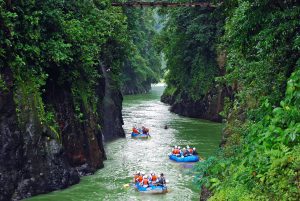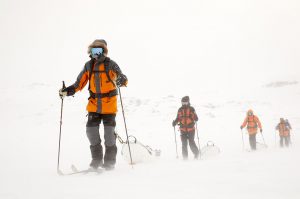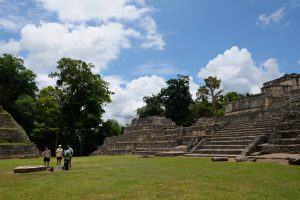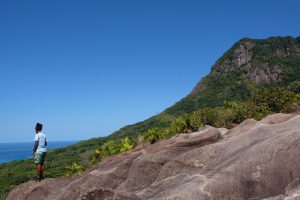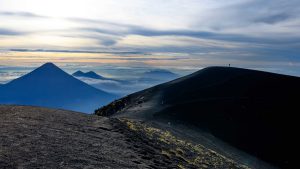
Framed by a necklace of puffing volcanoes and the glassy Lake Atitlán, Guatemala’s Western Highlands are the stronghold of modern Maya culture. Here, indigenous communities are steeped in faith, and traditional rites draw on the beauty of the land
Read online at nationalgeographic.com
There’s an unnerving tranquillity to Guatemala’s cloud forest, arrayed as it is here across the slopes of a towering volcano. Its beauty is delicate, ripped from the pages of a fairytale: boughs drip with tangled beards of moss; thick, glassy droplets hang from pine needles; and fingers of ferns are glossy-wet. Shifting mists blot the sky and half-obscure my path, forcing the foreground into focus; amid the black soil at my feet, I spot minute white blooms, like pinpricks of light. There’s a stillness and silence in this glade that belies the molten lava seething somewhere deep, deep beneath the earth — and the chaotic scene lower down the steep mud road.
I hear a distant shout — “Vamos! Let’s go!” — and retrace my steps out of the wood to where our 4×4 is still wedged, at a tilt, in a pothole. Members of our camping expedition are wiping sweat from their foreheads and throwing dirt-caked shovels into the trailer; I hurriedly wedge the branches I’ve gathered under the tyres and jump in.
At the wheel, my guide, Vinicio Peña (Rambo, to his friends), revs the engine. “Come on, my son,” he whispers affectionately to the truck, eyeing the rutted incline ahead. A crucifix dangles from the rear-view mirror.
The wheels spin and then we shoot forward, the truck careening over the track’s ditches like a wild thing possessed. “Yeehaw!” Rambo shouts, shifting through the gearbox. The forest’s outstretched limbs batter the bonnet and scrape at the windows, as if warning us to turn back. I spy a hairpin bend ahead, and acres of open sky over the verge, and screw my eyes shut.
When I open them again it’s because he’s switched the engine off. The forest has spat us out onto a rubbly plateau, wrapped in clouds and crowned by skeletal vegetation. “You have to be a little mad to come here,” Rambo laughs. And then, clutching his chest: “It’s like I have two hearts! Do you feel that?” I don’t know if he’s referring to the thrill of the ascent or the effects of high altitude. The air is noticeably thinner: we’re around 10,500ft up. From here we’ll hike to the trailhead and pitch camp; at dawn, we’ll make our ascent to the summit of Acatenango, Guatemala’s third-highest peak.
There’s a flash of light, an air-splitting peel of thunder and the first drops of rain. We grab our kit bags from the truck; Emeralindo and Fernando, the porters, using a forehead strap to balance giant bundles on their backs. Raphael Chicojay Diaz, another guide and the trip’s mountaineering expert, falls into step with me at the rear as the storm breaks in earnest. The path beneath our feet is black: ash and pumice. “This is Guatemala,” he says. “Fire and water.” There’s another distant rumble, but this time it travels through the earth; I can feel the percussion in my bones. Raphael raises an eyebrow and grins at me. “I don’t think that one was thunder,” he says.
We’ve been unlucky with the weather — typically, between late October and April there’d be nothing but warm days and clear vistas. But our team makes the best of it, cheerfully gathering inside the kitchen tent to share stewed chicken, hot chocolate and stories. Rambo has been guiding for 30 years, he tells us; before that, he was in the Guatemalan army during the country’s brutal civil war (1960-1996). “In that life, I was a soldier, a paramedic, a paratrooper, and I worked on anti-narcotics projects too,” he says. “But becoming a guide, learning more about our history and culture, has been the best thing that ever happened to me. I understand better both sides of the conflict, and what happened to the people caught in the middle.” Raphael, in turn, speaks about expeditions and adventures across Guatemala. “Acatenango is my favourite volcano — I like a challenge. I’ve climbed 12 of Guatemala’s 37,” he says. “None of the three active ones, though,” he adds, ruefully.
When we exit the kitchen to return to our own tents, the sun has set and the clouds have cleared. The villages of the valley below are lit up like Christmas but the night seems unusually dark. There’s not a star in sight — the sky is concealed behind a hulking volcano. Fuego, Acatenango’s noisy neighbour, just three miles to the south, fires off a flaming volley of rocks. Neon-red ash and boulders spew into the sky, tinting the remaining clouds apocalypse rouge, then tumble earthwards, illuminating the upper cone. The sound of the explosion — just like the rumble heard on our walk — reaches us a moment later. “That was a big one!” Raphael cheers. “Try to get some sleep before the climb, if you can.”
The ‘climb’ turns out to be an undignified two-hour scramble in volcanic scree. For every stride I manage — heart-pounding, leg muscles screaming — I slide two back. As dawn breaks, Raphael and I switch off our headlamps, soak up the view and catch our breath. (We’d left a poorly Rambo behind. “The volcano wasn’t the only one exploding in the night,” he’d joked, clutching his stomach and nodding to the latrine pit apologetically.) The undulating landscape of Guatemala’s Western Highlands is laid out beneath us like a map. Raphael points out Antigua, a romantic colonial city of tumbledown cathedrals and cobblestone lanes, glittering below us; and, behind a cluster of peaks, the half-moon of the freshwater Lake Atitlán. There are neat patchworks of coffee plantations, too; miles of misty ridges and valleys, dotted with indigenous villages; and then, at the edge of all this, the Pacific Ocean, stretching to meet the sky. “It’s even better from the top,” Raphael says, nodding to the final, near-vertical slope.
When we finally reach the summit — a heady 13,000ft high — and circumnavigate Acatenango’s wide caldera, we can see our place at the centre of a corridor of volcanoes. They stretch away from us, ancient and indifferent, in each direction. “They all have stories, they all have characters,” Raphael says, rapturously. On one side, Fuego (the Spanish word for ‘fire’) puffs away, blowing ash clouds into the morning blue like a committed pipe smoker. On the other is the fearsome isosceles of Agua (‘water’). In the middle, atop Acatenango, there’s us: tiny mortals who’ve dared to climb onto the shoulders of a titan, caught between the elements.
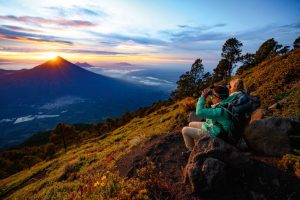
The house of masks
The spectacular geography of Guatemala’s Western Highlands is matched by its cultural importance. Under Spanish rule, with little to plunder, this remote, mountainous region remained a backwater, and the traditions of the Maya were able to flourish — eventually binding with those of the Catholic church. Today, the area is considered a stronghold of indigenous culture.
“You see, we have two types of Maya culture — that in the stones, in archaeological sites like Tikal or Uxactún in the Petén lowlands to the north. And then there’s this: living culture,” Rambo says in a reverential whisper, as a troupe of costumed dancers fill the courtyard.
We’ve come to the house of Diego Ignacio, a renowned mask carver and shaman in the market town of Chichicastenango. Diego died four years ago, leaving his widow, Juanita, and their adult children to continue the family business in his name, which includes performing cultural dances. Rambo is a close family friend; he’d saved Diego’s life during the civil war, and is godfather to many of the children playing at our feet. “I’ve spent many nights in this house. Many memories,” Rambo says sadly.
The Dance of the Deer begins. Decked out in brocaded finery and painted animal masks, five dancers hop and weave between each other. The music is reedy and rhythmic; to one side, men beat drums, shake maracas and play the mournful, oboe-like chirimía. “This is traditionally performed on 21 December to celebrate the winter solstice and the feast day of Saint Thomas. The Highlands have so many traditions you just don’t see in the cities,” Rambo says.
When the dancers have bowed and our applause has finished, Diego’s son, Miguel, takes us on a tour of the property. First, there’s the 200-year-old temazcal, a type of sauna used to treat spiritual and physical ailments through massage and communion with ancestral spirits. Inside the low, brick dome there’s fragrant pine on the floor and lingering heat from a recent ceremony. Here, Miguel blesses me with rose water and “brushes negativity” from my head and shoulders with a garland of herbs.
Next is the morería (mask workshop). The walls and ceiling are lined with carved lions’ heads, large-beaked birds, gargoyle faces and other, indeterminable creatures — all sold to passing travellers or hired out for local ceremonies. A large framed photo of Diego rests on an altar among Catholic Madonnas, Maya carvings and a Stetson-wearing effigy of the local trickster spirit Maximón. “Diego would be sitting there, with his leather apron, whittling masks,” Rambo says, his mind caught in an eddy of the past.
For a country still healing from war, Guatemala is surprisingly attached to grenade-like fireworks and crackers that sound like rifle fire. The rockets start going off at first light. When Rambo and Raphael meet me at breakfast, they seem thrilled to have had their sleep interrupted: “This means the Maya brotherhoods are honouring a feast day,” Rambo says. “Hopefully we’ll catch a parade.”
We’ve arrived in Chichicastenango in the run-up to All Souls’ Day (2 November), a celebration more commonly known here as the Day of the Dead. Crowds are moving towards the cemetery with candy-coloured paint and bundles of golden marigolds to spruce up the family plot. Moving against them is a long procession of costumed Maya holymen carrying instruments, fireworks and feathered floats bearing Catholic icons. Adding to the mayhem: it’s also market day. The cobbled streets are a riot of colour and movement, packed with makeshift stalls hawking fruit, antiques and the hand-stitched huipil blouses favoured by indigenous women.
We climb the stone steps of Santo Tomás Church for a better view; all around us is the hullaballoo of families swinging incense barrels, lighting small pyres of tobacco and kindling, and praying urgently in Maya languages. “Do you notice anything funny about these steps?” Raphael asks. “It was an ancient Maya temple — see, there are 18 levels, one for each month of the Maya calendar. The Spanish razed the building in 1540 and built on top of the platform, so it’s now a holy site twice over.” Rambo chimes in: “There was some damage done by the church in the early days. But we learned to accept each other, to weave the traditions together. What matters, ultimately, is belief, trust, faith. And that’s what these people have: faith.”
Back at the morería, we catch up with Juanita, who’s made time to offer us a blessing. We follow her up a hill to a sacred forest clearing. Fire pits mark the cardinal points. After sinking to her knees in prayer in front of a stone idol, Juanita gets to work constructing our offering. First, she sketches out an ornate cross in sugar, then piles on kindling, copal (tree resin), tobacco, chocolate and multicoloured candles. “Each colour signifies a different petition: for money, protection from envy, love, warding off evil,” Rambo whispers. “And see how she ties her tzute (shawl) around her head; this helps contain your essence and harness your wisdom.”
The flames rise. Behind the smoke, Juanita chants in Maya Ki’che’. “Look how the fire behaves. If you know how, you can visualise messages in the flames,” says Rambo. “She’s talking to the spirit of the mountain.”
We’ve each been given a candle to cast into the fire. Juanita waves us forward. “She says we’re to say a prayer for those we’ve lost,” Rambo translates. He lingers for a few moments, looking searchingly into the fire, before dropping in his candle and turning away.
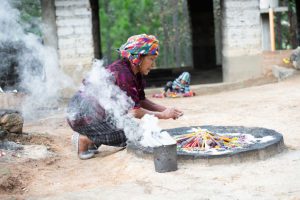
Up in the air
Tourism in Guatemala is far from booming, although its star is rising. For many years, the headline-grabbing crime statistics coming from the capital city deterred many; its jungle-swathed Maya ruins on the Mexican border and the cultural riches of the Highlands were the preserve of only the intrepid. “It’s safer than you think,” Monica, a manager at the chichi Lake Atitlán boutique hotel Casa Prana, tells me, laughing. “I moved here from the city — that’s where the crime is. Now I don’t have to lock my door. Guatemalans are well known for being friendly and welcoming, and around this lake people are especially kind.”
In front of the hotel’s breakfast terrace, Lake Atitlán is pearlescent in the morning light, the shadow of two volcanoes etched on its surface. Not far from the hotel’s jetty, a few fishermen are at work in wooden canoes.
Around the lake’s edges sit villages: San Antonio Palopó, famous for its pottery; Santiago Atitlán, the birthplace of the colourful cult of Maximón; and Santa Cruz, renowned for its backpacker vibes. I paddle over to the latter in a kayak, past a shore dotted with the summer houses of wealthy politicians, and then whizz uphill in one of the village’s signature red tuk-tuks to Café Sabor Cruceño.
The views are spectacular — behind us is a thickly-forested zigzag of hills, gorges and waterfalls, and below, falling away to the glittering shore, is a chaotic jumble of roofs, washing lines and lanes. Turning away from the scenery, attention is fixed on the menu: “These are all really local dishes. Look, tayuyos,” Rambo exclaims. “They’re corn dough wrapped around black bean paste. Guatemalan food like this is cooked in homes. But restaurants usually go for international dishes. This is quite a special place,” he says, waving the waitress over.
The same is true of Antigua, the elegant colonial capital of the Spanish from the early 16th century until the earthquake of 1773. Today, it’s the centrepiece of Highlands tourism. “We have more ingredients than Mexico — so many ethnic groups, so much richness,” Rebeca de León, founder of the local Guatemalan gastronomy tour operator Kukul Tales, tells me. “Why aren’t we showcasing this in our restaurants?” We’ve met in the restored, colonial-era kitchens of Antigua’s Casa Popenoe museum to sample some real Guatemalan cuisine. She’s got me grinding black salt and white chiltepe peppers into roast tomatoes with a pestle and mortar. “If you want to imagine how the original Mayans ate, look to chirimol,” says Rebeca. “The sauce you’re making has been the basis of our cuisine for centuries.”
We move on to taste stuffed corn dough tamales, and a spicy, shredded-beef stew called hilachas, washing them down with tiste, a drink made of ground cocoa and toasted corn. “Our food is seasonal and historic; some of these dishes are even ceremonial,” Rebeca explains. “People learn about culture through what they eat. I’m proud to show this to travellers. But it’s a real problem that new generations of Guatemalans would rather buy sushi than cook. Our cuisine is at risk of being forgotten in our grandmothers’ recipe books.” Dinner concludes with dulce de ayote — pumpkin boiled in spices and sugar. “I wanted you to try this,” says Rebeca. “In the north, they’ll eat it this week to celebrate Day of the Dead.”
In Guatemala, the iconography of this festival is different to that celebrated in Mexico — there are no grinning skeletons here. Rather, festivities are distinct and regional: in the Highlands village of Todos Santos, men engage in a day-long, death-defying drunken horse race back and forth along a short dirt track; and outside Antigua, in the communities of Sumpango and Santiago Sacatepéquez, locals spend all year building towering paper-and-bamboo kites that are judged on 1 November, All Saints’ Day. “The tradition for kite building started because there were bad spirits here,” Raphael tells me as we join the hoards moving towards the main cemetery of Santiago Sacatepéquez. “For us, when you fly a kite you release the spirit of the dead — you communicate with your ancestors.”
The Giant Kite Festival is in full effect; between the tombs, families are enjoying picnics, serenaded by folk bands, and parents are teaching children to fly little hexagonal kites. The air is full of fluttering shapes and streamers. Along the perimeter of the cemetery are the show-stoppers — kites so tall they’ve been propped up with house-height bamboo struts and moored to the earth by thick ropes. In the rising wind, they strain against these shackles like caged animals. “They’re too large to fly,” Rambo explains. “The medium ones, they’ll try to get them airborne later. But with the giant kites, it’s more about the message they’re conveying.” In recent years, the delicate collages pasted across the kites have spoken of deforestation, indigenous rights and the scourge of domestic violence. This festival honouring the dead has become tangled up in issues of the living; it looks to the future as much as the past.
Raphael climbs a mausoleum, paper kite clutched in hand. There’s a boyish grin on his face as he throws it upwards and unspools the line. The kite doggedly rises through the aerial network of strings until it’s a speck in the sky. The views from up there must be incredible: a mass of volcanoes and virgin forests stretching to the ocean. “We’ll let it take our messages to heaven,” he says, handing me the line to release. It sags and pools for a moment, then whips into the air. We watch it go.
Our kite — along with our missives to the beyond — is now at the mercy of the elements.
Getting there & around
Flights from the UK to Guatemala City typically transfer through hubs in the American south east — including Atlanta (with Delta) or Houston (with United Airlines) — or Madrid (with Iberia).
Average flight time: 15h.
During the rainy season (May-October), roads in the Western Highlands are subject to mudslides; it’s best to organise transfers with a driver or guide.
When to go
The dry season is November to April. The wet season is sunny with frequent showers. Year round, the weather is mostly warm during the day and cool in mornings and evenings, averaging 26C.
Where to stay
Mayan Inn, Chichicastenango.
Casa Prana, Lake Atitlán.
Finca in the Clouds, outside Antigua.
Posada del Angel, Antigua.
More info
visitguatemala.com
lata.travel
How to do it
Audley Travel offers 11 days in Guatemala from £5,630 per person (based on two sharing), including one night camping on Acatenango, two nights at Lake Atitlán and three nights in Antigua, plus one night in Guatemala City, one night camping at Uaxactún and one night near the ruins of Tikal. Includes all flights, private transfers, accommodation with some meals and privately guided excursions. audleytravel.com
Published in the May 2020 issue of National Geographic Traveller (UK)





